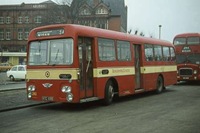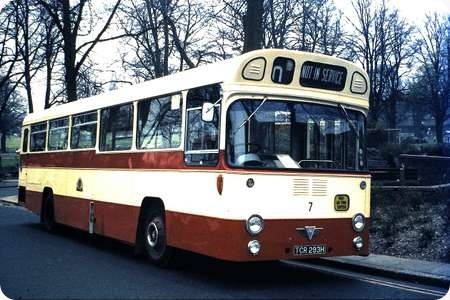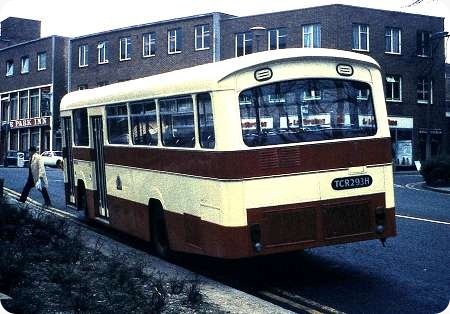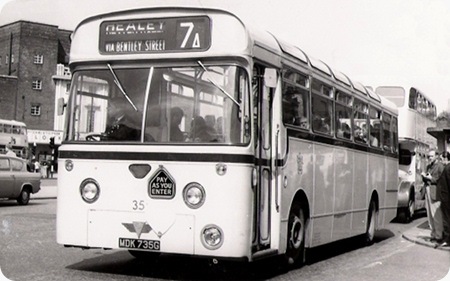Lancashire United Transport – AEC Swift – NTC 109G – 292
Lancashire United Transport
1969
AEC Swift MP2R
Alexander B43D
LUT’s single deckers were often a little different from the norm. This AEC Swift was one of three (291-293) delivered in either late 1968 or early 1969 (sources differ) along with some similarly bodied Bristol RESL’s. Their Alexander bodies were based on the W-type, but featuring short window bays, flat glass, V-shaped windscreens, and a plain front roof dome, rather than the more common version with long bays, curved screen and peaked dome. Interestingly they appear to have retained the curved rear screen though.
The Swifts did not find favour and were ‘swiftly’ withdrawn in 1973 and sold to neighbouring St. Helens Corporation, with whom they retained the same fleet numbers.
Photograph and Copy contributed by John Stringer
19/05/13 – 11:31
The Bristols, delivered at the same time, had a three part rear window arrangement including a full depth emergency exit door in the centre. Short window bays also appeared on the Plaxton bodied Seddon RUs and Bristol REs, delivered up to and including 1974.
I always thought the Alexander bodies, with their deeper window line, were better looking than the Plaxton bodied Seddon RUs and Bristol REs. and decidedly superior to the, at best, unattractive Northern Counties LH6Ls delivered in 1969.
The Swift’s short service duration with the company has always been a matter of conjecture. Was it the reputation the type was rapidly gaining in London or, much more likely, the fact that the power plant wasn’t a Gardner or, at a push, a Leyland.
Phil Blinkhorn
19/05/13 – 12:08
As we saw with the DM(S) Fleetlines, failure in London was not necessarily a reflection on the vehicle – more on the rigid London "system". As an AEC man, I would accept that the Swift (& Merlin) wasn’t their finest hour – but wasn’t as bad a the Panther and certainly not the disaster that was the Roadliner. It just wasn’t the RE! St Helens, Morecambe and Leeds – not to mention in a smaller way, Sheffield – gave them full service lives. [OK. I haven’t forgotten East Kent.]
I think Phil’s final paragraph has it in a nut-shell. Non-standard – and not Gardner.
David Oldfield
20/05/13 – 07:33
Did Alexander classify these bodies as W-type? I think the more anonymous front front panels, and dome – OK the whole front! – has stood the test of time better than the "classic" W-front (and would probably be cheaper to repair in the case of any lower front panel damage). I think the three-window/smooth dome of the REs probably sat better with this frontal design than the "classic" curved-screen/peaked dome. For me though, the biggest single improvement over the usual W-type body has to be the straight window-line fore and aft. RE/RU/Swift/LH/Plaxton (bus bodywork)/Northern Counties/Alexander/LUT/LT/St Helens – I’d forgive them all shallow window-lines, inflexible practices, less-than reliable offerings etc, just to have them still around . . . I can’t see myself offering opinions on some First/Arriva etc Wright etc thingy 40+ years down the line. Its 44 years – this photograph is closer to 1926 than today!
Philip Rushworth
20/05/13 – 07:34
Four of the Sheffield two-door Swifts were sold to Hardwicks at Scarborough when they were just over three years old, and supposedly even one of those they acquired by default. Story has it that one of the buses they’d agreed to buy couldn’t be persuaded to start when they came to collect it, so they ended up taking a different one instead!
Two of the quartet, TWE 21F/22F got themselves sold on to Stokes of Carstairs a few years later, and when asked about the pair during a depot visit on one occasion, Mr Stokes himself suggested that the only good thing about the two of them was that they kept a fitter in full time employment!
Dave Careless
20/05/13 – 09:08
That quip made my morning, Dave C – don’t you just love black humour!
Chris Hebbron
20/05/13 – 09:09
And a Ribble Lowlander in view: from the (almost) sublime to the ridiculous – please refer to the Ugly Bus Page . . .
Pete Davies
20/05/13 – 11:36
As far as I know, Dave’s story is correct. You need a bit of black humour on a grey and gloomy Monday morning…..
David Oldfield
20/05/13 – 16:56
Glad you enjoyed that one, Chris and David! Again, it’s not only the vehicles, it’s the people involved with them that make this hobby of ours so fascinating and, at times, wonderfully entertaining.
And you’re not alone with respect to the Monday morning weather, it’s equally as dark as the humour here in Nova Scotia also!
Dave Careless
20/05/13 – 16:58
This style of body was also bought by Cardiff also on Swift chassis. Although LUT had bought Marshall bodies with a wrap round windscreen. They reverted to an almost fifties appearance for their Plaxton bodywork on Seddons and Bristols one wonders if this was a cost saving measure as a small two piece windscreen would be much cheaper to replace. The NCME ones were the standard product which was a strange mixture of styles that didn’t gell The next LUT saloons with wrap round windscreens would be a batch of Leopards with Plaxton bodywork which were LUTs swan song as an independent operator.
Despite their outer appearance I always had a soft spot for Ribbles Lowlanders they were certainly an improvement on a "lowbridge" Atlantean
Chris Hough
21/05/13 – 07:37
You’re right about the Lowlander Vs Lowbridge Atlantean, Chris! I have experienced the preserved Silver Star example of the latter style on a number of occasions. It doesn’t look right, somehow!
Pete Davies
21/05/13 – 07:38
Like St Helens, Blackpool also had a fairly large fleet of AEC Swifts which seemed to have full service lives.
Philip Halstead
21/05/13 – 12:40
Portsmouth Corp’n had 12 AEC Swifts in 1971, lasting 10 years. They went with some slightly older Panther Cubs and some slightly newer PDR2/1’s, seemingly part as a cleanout of single-deckers than for unreliability reasons. I seem to recall some of them finishing up with Basil Williams (Southern Motorways), actually owned by White Heather and which, during a rail strike, were used to ferry folk, working in the City, to London every day! Basil acquired quite a collection of Swifts/Merlins in the end. He’d earlier owned ex- London Transport GS’s, of course!
Chris Hebbron
21/05/13 – 15:50
Yes, Chris H, Portsmouth had 12 AEC Swifts (new 1969) with Marshall bodies, and these had wrap-round windscreens, which I always assumed were "BET style" (or similar). The 26 Panther Cubs (14 Marshall + 12 Met-Camm) were similar in appearance. The 12 PDR2/1s that followed in 1971/72 were unusual in two respects – saloon bodies on a d/d chassis, and Seddon as the manufacturer. Pompey began to withdraw the Panther Cubs in 1977, but some of them along with all the rest were still in service in 1981/82 when the MAP project was carried out. The drastic recasting of services saw all the remaining Panther Cubs, all the Swifts and some of the PDR2/1s leave the fleet, along with 14 5-year old Leyland Nationals! As you say, at least two of the Swifts ended up with Basil Williams of Southern Motorways fame. By the time deregulation came in, Williams had some ex-London Swifts/Merlins, too, and repainted them in his original Hants and Sussex red and cream livery, using that fleet name, too. A non-enthusiast friend of mine travelled on one of the ex-London ones said it was a "fantastic vehicle". Make what you will of that, good people – an ex-London bus, around 18 years old, run by Mr Basil Williams, in the opening days of deregulation…
Michael Hampton
21/05/13 – 16:50
Amazing, Michael H, that a generally derided vehicle of such age and with standard London Country bus seats should get such glowing praise. Basil Williams must have had great faith in these vehicles to let them loose on the 150-odd mile return journey to London every day, although he would not have owned them for long at that stage!
Chris Hebbron
22/05/13 – 07:27
Chris, from my own knowledge of the Basil Williams empire, and my personal experience of driving GS 43 (Southern Motorways – Guy GS – MXX 343 – Ex LTE GS 43 on this site), I believe that faith formed a major ingredient of his maintenance procedures.
Roger Cox
22/05/13 – 17:46
Just to clarify the earlier note, my non-enthusiast friend travelled on the ex-London Swift on a local route, not a London marathon. Memory says Williams used route no 451 for a service from Portsmouth to the Emsworth area. Always with grandiose ideas of route numbers, it didn’t clash with the competition!
Michael Hampton
23/05/13 – 07:49
As most of you will know from the cover of a recent issue of Bus & Coach Preservation magazine, the Cardiff Transport Preservation Group has ex-Cardiff Swift/Alexander 512 and it’s still living up to the breed’s reputation as rather troublesome beasts.
Its arrival at last year’s Merthyr Rally all the way from Barry depot brought forth some expressions of surprise and relief from members at its safe arrival but we weren’t allowed to go anywhere on it, just in case!
There may come a day when we use it to go on one of our summer evening runs, but it’s not likely to happen soon.
Berwyn Prys Jones
04/07/13 – 17:33
Leeds had the largest provincial fleet of Swifts eventually having 150 in service. They were by no means perfect but had a normal lifespan. The last 1971 batch were by far the best with more powerful engines. When the PTE took over in 1974 they went for Leyland Leopards and Volvo B55 chassis. The first Nationals (other than a one off delivered to Leeds) were Mark 2 examples which were followed by Leyland Tigers in 1983.
Chris Hough
14/07/13 – 14:25
Just wished I could have driven one of these Swifts in my LUT days and I could have told you all about them. They were allocated to Atherton and try though I may to get one whenever a changeover in ‘foreign depot’ territory was required, I never could. I did not previously know about their rear end having a single windscreen as against the similar looking but Bristol RE’s, that we had at Swinton, which as is stated had three piece rear windows that included the emergency door. They did not, as far as I saw spend much time on the hard working 84 (ex trolley bus service) and of course as soon as the Seddons arrived, even their look alike Bristols were taken off the 84 in their favour. Wide doors, good acceleration, great brakes, comfy thought out cab, no wonder the Seddons became everyones favourite, myself included.
Mike Norris
 Vehicle reminder shot for this posting
Vehicle reminder shot for this posting
11/04/16 – 16:22
LUT First Flat fronted bus was the Wulfrunian.
The first Daimler Fleetline to arrive was fleet number 98 it should have been 97 but wasn’t finished in time for the driver to drive it back to Atherton.
Mr Anon
12/04/16 – 06:05
Mr Anon may be right about LUT buses but the coaches in the 1950s starting from the Duple (Midland) Britannias and the following Burlingham and Northern Counties batches had a very plain frontal appearance.
Stephen Allcroft
13/04/16 – 13:38
"Leeds had the largest provincial fleet of Swifts eventually having 150 in service. They were by no means perfect but had a normal lifespan." (04/07/13)
With respect Chris H (Chris Hough) but wasn’t the total of Leeds Swifts 120, plus 30 Fleetlines making the total of 150 OPO single deckers of that pattern ??
Sorry its taken me three years to spot this – par for the course, old age you know !!
Chris Youhill
Quick links to the - Comments Page - Contact Page - Home Page




